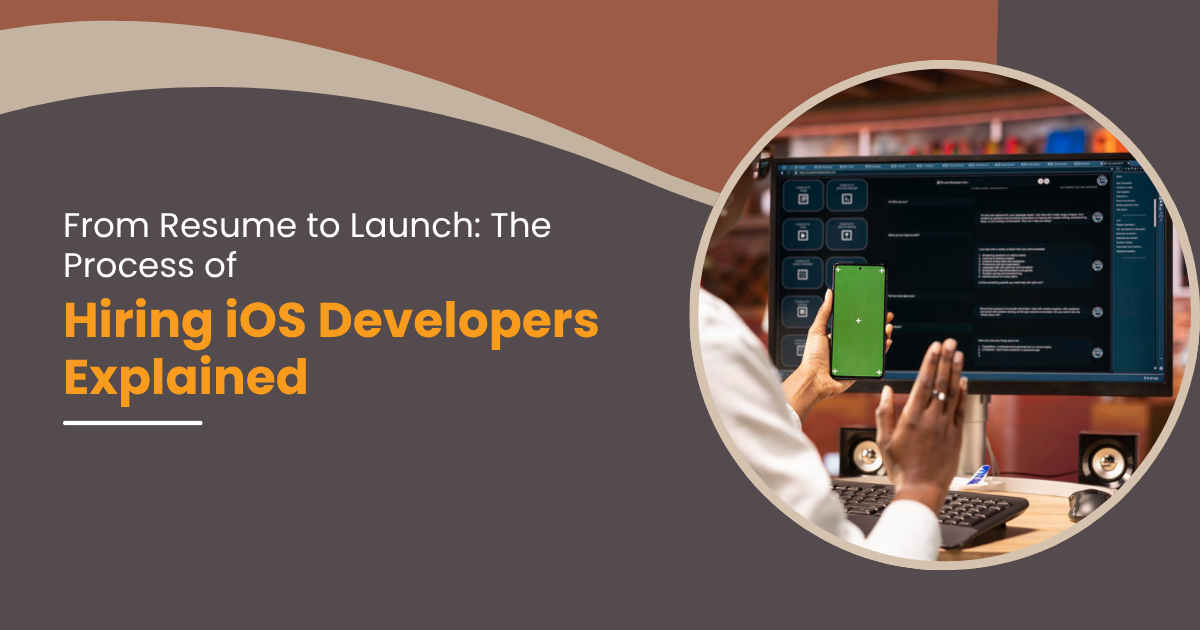From Resume to Launch: The Process of Hiring iOS Developers Explained

In 2025, demand for native mobile skills grew sharply: software developer roles needing iOS rose 22 % by 2030. Average salary in the US sits at $129,500 annually, while hires take about 35–45 days from posting to offer. Onboarding and training takes another 1–3 months. These facts show why a rigorous process matters when you need to Hire iOS Developers. A poor process leads to mismatches, delays, budget overrun, and poor app quality. From resume screening to final launch, you must maintain technical discipline, evaluation accuracy, and structured onboarding.
Why Hiring iOS Developers Requires Care
iOS apps demand native hardware access, responsive UI, and performance. Mistakes lead to crashes, App Store rejection, or poor user reviews. Hiring wrong talent can stall a project. Technical evaluation during hiring ensures code quality, use of Swift, SwiftUI or UIKit, and knowledge of Frameworks like ARKit or CoreML. It also ensures familiarity with test automation, CI/CD, and version control workflows.
Define Clear Requirements First
Create a detailed job spec. List required skills: Swift, Objective-C, SwiftUI, UIKit, REST APIs, Core Data, unit testing, CI/CD. Specify experience level and domain: fintech, health, or enterprise. Include expectations for architecture patterns (MVC, MVVM), async handling, performance profiling, and code review practices. Clear specs attract matched candidates and reduce screening load.
Resume Screening and Shortlisting
Review resumes for relevant experience and technical details. Focus on projects using SwiftUI, ARKit, CoreML, or Combine. Prefer candidates with GitHub or portfolio links. Watch for contributions to open source or technical blogs. Avoid resumes that only list buzzwords without outcome metrics.
Technical Evaluation
1. Coding Test
Use a timed coding test focused on typical iOS patterns: table view implementation, REST API integration, or simple Core Data persistence. Keep tests under 90 minutes. Evaluate code clarity, architecture, error handling, and testability.
2. Take‑home Assignment
Provide a small app challenge: building a weather or notes app with offline storage and UI responsiveness. Ask for unit or UI tests. Assignments help evaluate structure, performance, and user experience.
3. Live Technical Interview
Invite shortlisted candidates to interview with lead engineers. Ask to explain the architecture of sample apps. Probe design trade‑offs, memory handling, concurrency, use of Combine or async/await. Ask about handling push notifications, background tasks, or App Store submission processes.
Soft Skills and Team Fit
Native development often requires collaboration with design, backend, QA, and product teams. Interviewers should evaluate candidates for communication, code review culture, and pairing ability. Ask about past team structures, release cycles, and handling of feature feedback or bugs.
Reference and Background Checks
Always request references from past clients or employers. Confirmed candidates delivered features on time, handled bug fixes, and maintained app stability through OS upgrades. Ask about version control hygiene, responsiveness to change, and post‑launch support.
Time-to-Hire Benchmarks
Glassdoor data reports the average interview process for iOS engineers takes about 14 days for the initial period. However industry data shows full hiring can span 35–45 days, depending on seniority. Onboarding and ramp‑up require an additional 1–3 months. Plan the hiring pipeline accordingly to meet launch deadlines.
Offer, Salary, and Market Rates
In 2025, entry‑level iOS developers earn $60,000–$80,000 per year in the US, mid-level $80,000–$120,000, and senior/lead roles $120,000–$150,000+. These numbers rise in tech hubs like San Francisco or New York. Freelancers may charge $100–150 per hour for niche skills like SwiftUI or CoreML. If hiring in India, expect much lower rates typically ₹5 lacs to ₹15 lacs per year depending on level and city.
Onboarding & Training
Once hired, onboard the developer with development tools setup: Xcode configuration, test devices or simulators, repository access, and project home. Assign a mentor for codebase navigation and architecture review. Training takes 1–2 weeks for tools and environment. Expect 1–3 months for performance ramp-up depending on app complexity.
Integrate Developer into Development Cycle
Include new hires in sprint planning, standups, backlog grooming, backlog estimation, and code reviews. Provide tasks aligned to their skill level, gradually increasing complexity. Review their pull requests and offer feedback. Encourage automated testing, crash analytics (Crashlytics or Sentry), and version control best practices.
Prepare for Launch Phase
Before launch, candidates should participate in final testing phases: Beta builds, TestFlight distribution, bug fixes, UI polish, performance profiling, and submission to App Store. They ensure compliance with App Store guidelines, handle provisioning profiles, certificates, and submission metadata.
Post‑Launch Support
Post-launch support is critical. Developers should monitor crash reports, analytics, and user feedback. They release patch updates, fix bugs, and adjust features for new OS changes. Availability for support and minor updates is essential. Also plan for future feature sprints or performance improvements.
Example Scenario: Hiring for Fintech App
Imagine hiring for a fintech app needing secure login, payment processing, and biometric authentication. You define clear job requirements for Swift, secure storage, encryption, REST APIs, and UI testing. You screen resumes for those skills and past financial app experience. You give a coding task to implement a secure login UI. In the interview, you ask about handling token expiry and keychain. After hire, onboarding includes mentor assignment and credential store setup. They deploy test builds, monitor crashes, and push updates before launch. That structured hiring process ensures technical quality and timeline alignment.
Why Technical Rigor Matters
iOS apps must meet high quality standards: memory leaks lead to crashes, UI freezes halve retention, poor error handling leads to rejection, and privacy flaws cause compliance issues. Native skills like SwiftUI, Combine, network layer design, secure data storage, and App Store packaging matter. A robust hiring process helps ensure that your team can build stable, performant, secure apps that users trust.
Conclusion
To Hire iOS Developers effectively, you need a clear, technical, structured process. Start with precise requirements. Screen candidates for real skills and metrics. Use coding tests and interviews focused on architecture and performance. Check references thoroughly. Offer competitive compensation aligned to location and demand. Onboard thoughtfully and integrate code reviews and CI/CD practices. Prepare for launch and post-launch support. This technical discipline reduces risk and boosts product quality. Missing any step risks delays, poor quality, or app failure.




